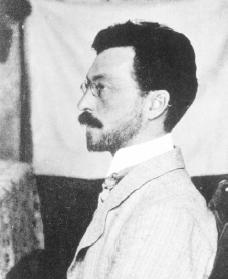Compiled by Katie Glackin

Wassily Kandinsky
by Cea., used under 
Wassily Kandinsky was born on December, 4 1866 in Moscow. He was born to musical parents, and his father was a tea merchant. When he was five years old, however, his parents divorced and he went to live in Odessa with his Aunt. There, he learned to play the piano and began studying drawing (Wassily Kandinsky, 2014). In 1886, Kandinsky went to the University of Moscow to study law at the wishes of his parents. He graduated with honors and then married his cousin, Anna Chimyakina, in 1892. He also took a position in the Moscow Faculty of Law and managed an art-printing works on the side (Wassily Kandinsky, 2014).
In 1896, however, Kandinsky experienced something that would change his life. He saw an exhibition in Moscow of French Impressionists. One of Monet’s paintings, Haystacks at Giverny, was of particular interest to Kandinsky because it was the first nonrepresentational piece of art that he had experienced (Wassiy Kandisky, 2014). Kandinsky was so influenced by this exhibition that he declined an offer of a professorship at the University of Dorpat to move to Munich to study painting (Smith, 1999).

Monet’s Haystacks
by Sharon Mollerus, used under 
Kandinsky first studied at a private art school and then moved on to the Munich Academy. It was there that he met Paul Klee, who would become a close associate of his (Smith, 1999). In 1903, he moved on to teach at the Phalanx Art School, where he met Gabriele Münter, a student at the school, and his mistress (Smith, 1999). He obtained a legal divorce from his wife, Anna, in 1911 (Wassily Kandinsky, 2014).
Up to this point, Kandinsky’s paintings had been realistic. It wasn’t until around 1909 that he had a revelation about his art. He had been painting a nature seen that day, and when he came back to his studio, it was twilight. He happened to notice one of his paintings as it was leaning against a wall, though he couldn’t quite recognize it as his own at first. He was struck by how the light hit the canvas and the shapes and lines that seemed to be created. The next day he tried to recreate what he saw and realized that painting subjects had restricted his art (Smith, 1999).
From 1910 to 1914, Kandinsky worked on creating abstract art. He became increasingly prominent during this time. He formed The Blue Rider in 1910 with his colleagues, Franz Marc and August Macke (Smith, 1999). When World War I began, Kandinsky had to move back to Russia and his work was temporarily stopped. He also had to leave Gabriele Münter behind; he had never married her (Smith, 1999). When Kandinsky was fifty years old, he met and married one of his art students, Neena Andreevskyaya, who was seventeen years old at the time (Wassily Kandinsky, 2014). In December of 1921 he returned to Germany, and in 1922 he accepted a professorship at the newly created Bauhaus (Smith, 1999). Kandinsky became a German citizen in 1928. Then, in 1933, the Bauhaus closed, despite Kandinsky’s efforts to save it. Kandisky felt no particular loyalty towards Hitler, so following the close of the Bauhaus, he moved to a Parisian suburb. He became a French citizen and lived out the remainder of his days there, until his death on December 13, 1944 (Smith, 1999).
References:
Smith, E. (1999). Vasily Kandinsky. Lives of the great 20th-century artists (). New York: Thames and Hudson.
Wassily Kandinsky. (2014). The Biography Channel website. Retrieved 03:17, Apr 07, 2014, from http://www.biography.com/people/wassily-kandinsky-9359941.